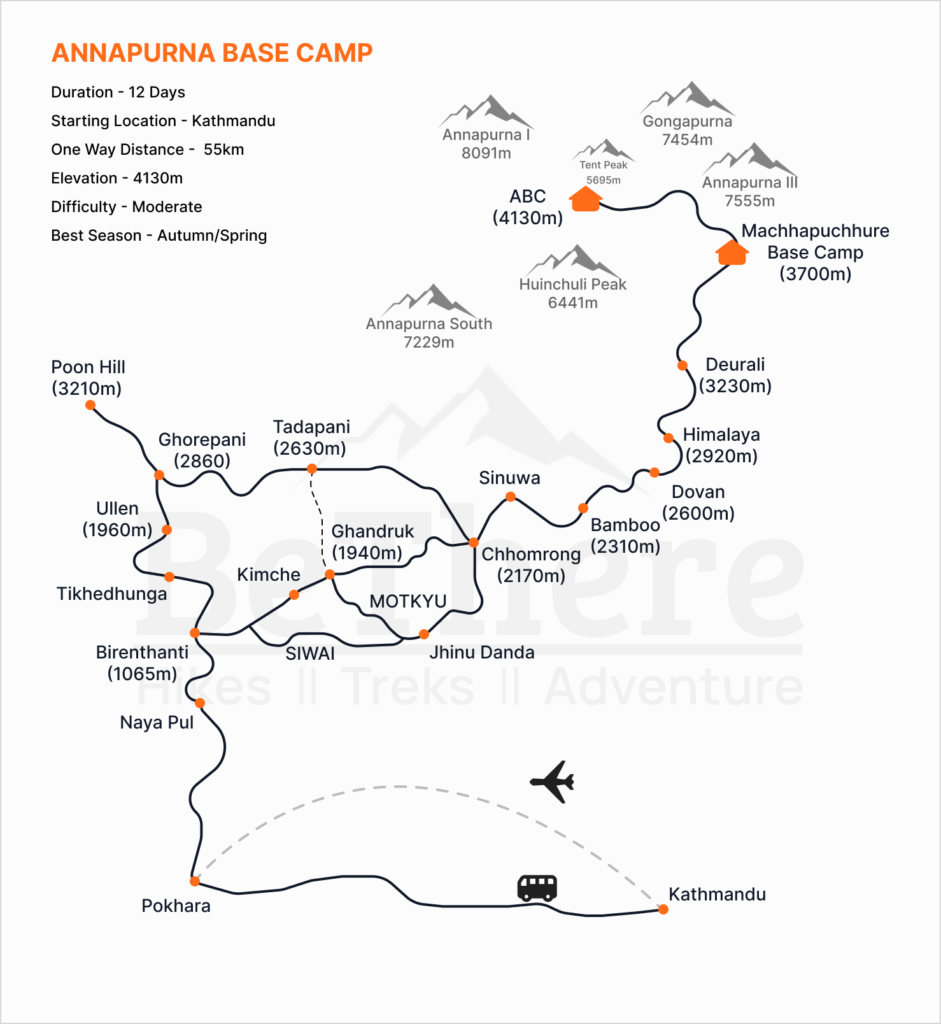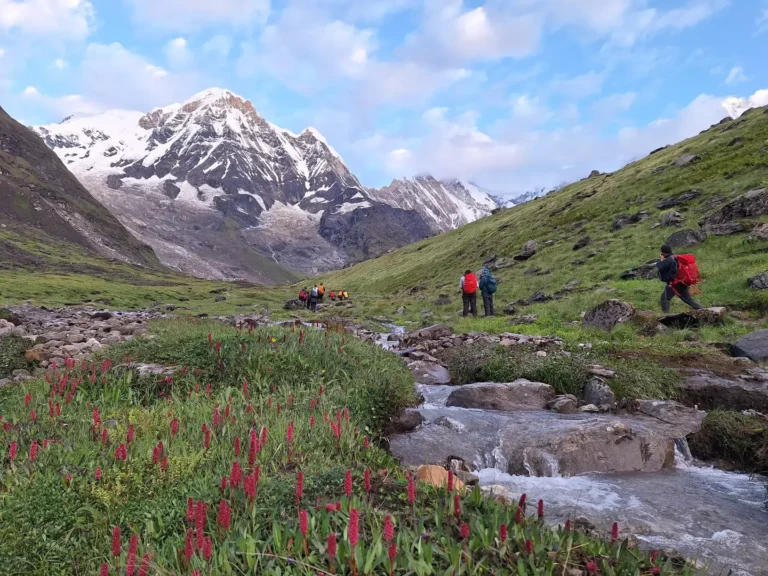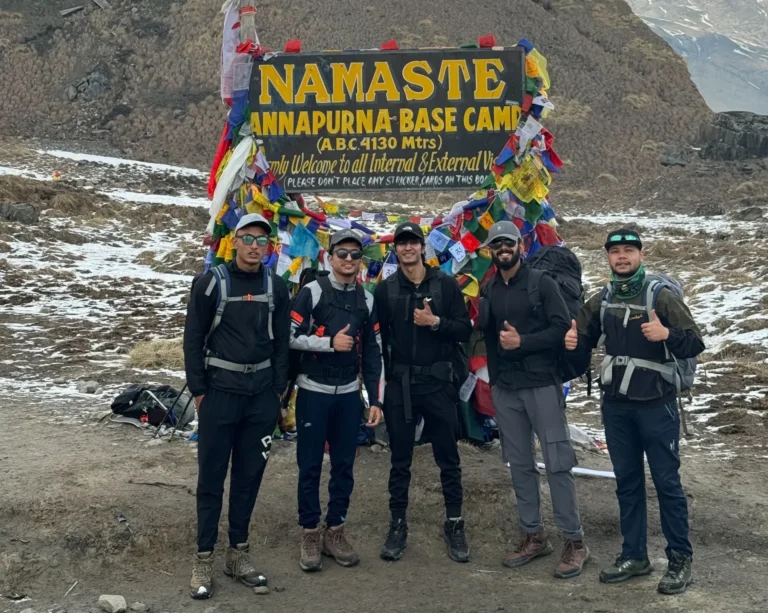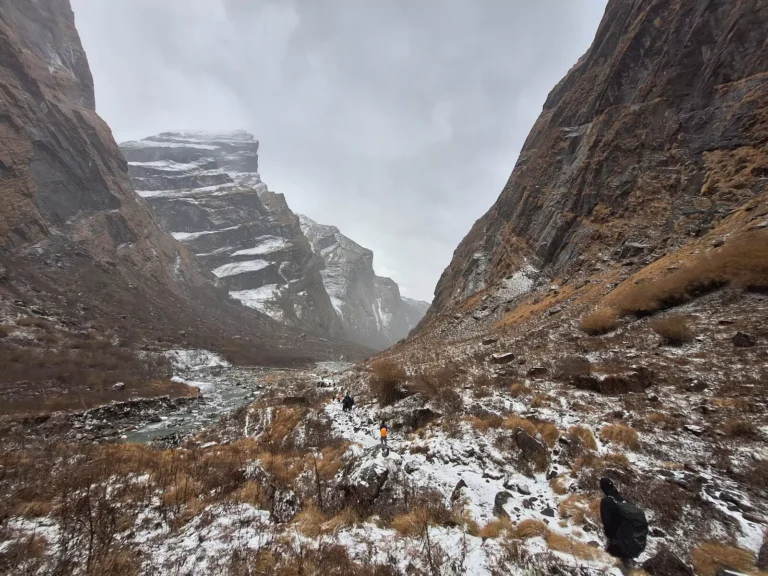Duration
12 Days
Max. Altitude
4130m
Difficulty Level
Moderate
One Way Distance
55km
Start/End Point
Kathmandu
Best Season
Autumn/Spring
Duration
12 Days
Max. Altitude
4130m
Difficulty Level
Moderate
One Way Distance
55km
Start/End Point
Kathmandu
Best Season
Autumn/Spring
Overview
The Annapurna Base Camp (ABC) Trek is one of Nepal’s most loved trekking adventures. It takes you deep into the heart of the Himalayas, offering breathtaking views, rich culture, and a true sense of mountain life. From the bustling streets of Kathmandu to the peaceful trails of the Annapurna region, this journey is filled with natural beauty and cultural charm. Along the way, you’ll pass through terraced fields, dense rhododendron forests, and welcoming villages like Ghandruk and Chhomrong, where you can experience the traditions of the Gurung and Magar communities.
As you climb higher, the scenery becomes more dramatic. Towering peaks like Annapurna I, Machhapuchhre (Fishtail), and Hiunchuli surround you as you reach Annapurna Base Camp at 4,130 meters. The sunrise views from here are unforgettable, with golden light spilling across snow-covered mountains. You’ll also get to soak in natural hot springs at Jhinu Danda, cross suspension bridges over glacial rivers, and stay in cosy teahouses that bring comfort at the end of each day. This trek is perfect for those looking for a rewarding Himalayan experience in a shorter timeframe.
The 12-day itinerary below gives you a clear picture of what to expect on this journey. Each day brings new highlights and unique experiences as you make your way toward the base of one of the world’s most famous peaks.
Highlights of Annapurna Base Camp
- Stand at the foot of Annapurna I (8,091m) and the sacred Machhapuchhre (Fishtail) peak.
- Take in breathtaking panoramas of nearby giants like Khangsar Kang, Varahashikar, Tarke Kang, and Hiunchuli.
- Trek through the Annapurna Conservation Area, home to lush forests and diverse wildlife like the Himalayan Monal and langurs.
- Explore traditional Gurung and Magar villages like Ghandruk, Chhomrong, and Landruk.
- Experience warm hospitality in cosy mountain teahouses along the trail.
- Unwind in the soothing natural hot springs of Jhinu Danda
- Witness Himalayan moraines and the striking Annapurna Glacier near base camp.
Best Season For Annapurna Base Camp Trek
The best time to embark on the Annapurna Base Camp Trek is during the pre-monsoon (spring) and post-monsoon (autumn) seasons.
Autumn (September to November) is considered the peak trekking season. After the monsoon rains, the air is fresh and crisp, offering some of the clearest panoramic views of the Annapurna range. The temperatures are comfortable during the day, though nights can be chilly.
Spring (March to May) offers mild temperatures and vibrant rhododendron forests bursting with colourful blooms. The weather is generally stable, and the mountain views are clear and spectacular. This is an ideal time to trek for nature lovers and photographers.
Trek Itinerary & Route Map
Day 01Arrival in Kathmandu (1,350m)
Arrive at Tribhuvan International Airport in Kathmandu, where our friendly team will welcome you and transfer you to your hotel. After settling in, attend a detailed briefing about your upcoming trek, covering the route, safety, and essential tips. In the evening, take a leisurely walk through the bustling streets of Thamel, and organize your trekking gear for the journey ahead. Overnight stay in Kathmandu.
Day 02Fly to Pokhara (820m) and Sightseeing
Catch a late morning flight to Pokhara, the serene lake city of Nepal, surrounded by stunning mountain views. Upon arrival, check into your hotel and take some time to relax. Later, explore the tranquil Phewa Lake, enjoy the lakeside ambiance. Experience the calm and charm of Pokhara as you prepare for the trek. Overnight stay in Pokhara.
Day 03Drive to Ulleri, Trek to Ghorepani (2,850m)
Drive from Pokhara to Nayapool via the highway, then continue on a rougher road to Ulleri, a picturesque Magar village. Begin your trek through lush rhododendron forests, charming streams, and traditional villages, steadily ascending to Ghorepani. Take in the natural beauty and immerse yourself in the local culture. Overnight stay in Ghorepani.
Day 04Hike to Poon Hill (3,210m), Trek to Tadapani (2,610m)
Start early for a hike to Poon Hill, one of the most famous viewpoints in Nepal, offering breathtaking sunrise views of the Annapurna and Dhaulagiri ranges. After capturing the stunning panorama, return to Ghorepani for a hearty breakfast, then continue trekking through dense forests and serene trails to reach Tadapani. Overnight stay in Tadapani.
Day 05Trek to Chhomrong (2,170m)
Descend gently through the lush forests into the scenic Kimrong Valley before beginning a gradual climb to Chhomrong, often referred to as the gateway to Annapurna Base Camp. Chhomrong offers picturesque views of the surrounding mountains and terraced fields. Overnight stay in Chhomrong.
Day 06Trek to Dovan (2,600m)
Cross the suspension bridge over Chhomrong Khola and start a steep climb to Upper Sinuwa. Continue trekking through bamboo and rhododendron forests, taking in the fresh mountain air and peaceful surroundings as you reach Dovan. Overnight stay in Dovan.
Day 07Trek to Machhapuchhre Base Camp (3,700m)
Trek along the serene Modi Khola Valley, surrounded by towering peaks and spectacular landscapes. Arrive at Machhapuchhre Base Camp, where you can enjoy the majestic views of Annapurna South and the iconic Machhapuchhre peak. This is the perfect spot to pause, relax, and enjoy the natural beauty. Overnight stay at Machhapuchhre Base Camp.
Day 08 Trek to Annapurna Base Camp (4,130m)
Today’s trek is shorter but immensely rewarding, taking you into the heart of the Annapurna Sanctuary. Arrive at Annapurna Base Camp, encircled by snow-capped peaks. Spend time soaking in the breathtaking views and enjoying the serene high-altitude environment. Overnight stay at Annapurna Base Camp.
Day 09Trek Back to Bamboo (2,310m)
Begin your descent, retracing your steps through the valley and enjoying the changing perspectives of the landscape. Arrive at Bamboo, where you can rest and reflect on the incredible experiences of the trek. Overnight stay in Bamboo.
Day 10Trek to Jhinu Danda (1,780m)
Follow the trail back to Chhomrong, then take a slightly different route descending to Jhinu Danda, famous for its natural hot springs. This is the perfect opportunity to relax and soothe your tired muscles after several days of trekking. Overnight stay in Jhinu Danda.
Day 11Drive to Pokhara via Nayapul and Fly to Kathmandu
Walk 15–20 minutes to the jeep point and enjoy a scenic drive to Nayapul. Continue to Pokhara airport and take a flight back to Kathmandu. Spend the rest of the day shopping for souvenirs or exploring local attractions. In the evening, join the team for a farewell dinner to celebrate the trek. Overnight stay in Kathmandu.
Day 12Departure from Kathmandu
After breakfast, our team will transfer you to Tribhuvan International Airport for your onward flight, marking the end of an unforgettable adventure.

Includes/Excludes for Annapurna Base Camp Trek
- Airport pick-up and drop-off
- Hotel stay in Kathmandu with breakfast
- 1 night hotel stay in Pokhara with breakfast
- All necessary trekking permits and a TIMS card.
- Transportation: Pokhara-Syauli Bazaar, Siwai-Pokhara (by private or shared jeep)
- Domestic flights: Kathmandu–Pokhara and Pokhara–Kathmandu
- All meals during the trek (B/L/D)
- Accommodation in lodges/guesthouses during the trek
- English-speaking guide and porter (2 trekkers: 1 porter)
- Staff salary, insurance, and equipment
- First aid kit and emergency oxygen
- Farewell dinner in Kathmandu
- International flights and Nepal visa fees.
- Meals in Kathmandu and Pokhara (except breakfast).
- Extra nights due to early return or bad weather.
- Personal expenses (wifi, laundry, hot showers, etc.).
- Travel and rescue insurance.
- Tips for the guide and the porter.
- Any services not mentioned in the inclusions.
Note
Please note that due to ongoing road construction along the Prithvi Highway, the drive from Kathmandu to Pokhara has become more time-consuming and dusty than usual. While this journey typically takes around 6–7 hours, current conditions may extend it to 8–9 hours due to traffic congestion and air pollution. We kindly ask for your patience and understanding during this transitional period.
Gears & Equipment
Item
Quantity
1 set of base/thermal Layer and 1 mid-layer
1
1 Set outer layer
1
1 waterproof jacket and 1 waterproof trousers, or raincoat/punchoo instead.
1
1 pair of lightweight trekking trousers or zip-off pants.
1
2 trekking t-shirts/shirts-merino is ideal
2
Four Season Sleeping bag.
1
Four Season Down Jacket.
1
1 pair liner gloves
1
1 warm wool hat
1
1 sunhat or similar
1
Sleeping bag liner
–
Travel towel
–
Sunscreen
–
Moisturizer
–
Lip Balm
–
Toilet Paper
–
1 rucksack/duffle bag for the porters to carry with your overnight kit
1
1-day pack (approx. 30ltr) with a waterproof cover
1
2 x 1ltr water bottles or CamelBak
2
1 x head torch
1
Water purification tablets
–
1 pair trekking boots (must be worn in)
1
Sandals or hut shoes
–
3 pairs thick walking socks / 3 pairs lighter walking socks
3
Running Shoes or sneakers.
1
Power bank
–
Thermal Flask
–
Adaptors: Nepal uses Type D, C and M
–
Accommodation and Food
During the Annapurna Base Camp trek, you’ll stay in locally run teahouses and lodges that offer basic yet comfortable rooms, often with shared or attached bathrooms. These accommodations are clean, welcoming, and provide an authentic Himalayan experience. In the cities of Kathmandu and Pokhara, you will enjoy stays in well-equipped hotels with modern comforts to help you unwind before and after your trek. Throughout the trek, you’ll be served freshly prepared meals three times a day, with a variety of local Nepali dishes like dal bhat, noodles, soups, and simple international options, along with tea or coffee at each stop.
Food Provided: Breakfast, lunch, and dinner during the trek; breakfast in cities. Meals are served fresh, and you can choose from available options at each lodge.
FAQs
1. How difficult is the Annapurna Base Camp trek?
The trek is considered moderate in difficulty. You’ll be walking for several hours each day on uneven and sometimes steep trails, but the altitude is manageable with proper acclimatization. A reasonable level of fitness and some prior hiking experience will make the journey more enjoyable.
2. Do I need a guide or porter for the Annapurna Base Camp trek?
A licensed guide is now mandatory for all foreign trekkers on the Annapurna Base Camp trek and other major trekking routes in Nepal. This rule was implemented by the Nepal Tourism Board to improve trekker safety and support local employment. Guides help with navigation, cultural insights, and safety, while porters can carry your heavy bags, letting you focus on enjoying the trek.
3. What kind of accommodation can I expect on the Annapurna Base Camp trail?
You’ll stay in teahouses, basic lodges run by locals along the route. Rooms usually have simple beds, and bathrooms can be shared or private, depending on the lodge. While not luxurious, these accommodations are clean, cozy, and provide a great way to connect with fellow trekkers and local culture.
4. How do I prepare for altitude sickness on the Annapurna Base Camp trek?
Altitude sickness can affect anyone, so it’s important to take it slow, stay hydrated, and listen to your body. The itinerary includes gradual altitude gains and rest days to help your body acclimate. If symptoms like headaches, nausea, or dizziness appear, inform your guide immediately.
5. What should I pack for the Annapurna Base Camp trek?
You should bring layered clothing to adjust to changing temperatures, sturdy hiking boots, a warm jacket for cold evenings, a good backpack, water bottles, snacks, sunscreen, and basic toiletries. Don’t forget your camera to capture the stunning mountain views!
6. What permits do I need for Annapurna Base Camp?
As of 2025, trekkers need two permits for the Annapurna Base Camp trek: the Annapurna Conservation Area Permit (ACAP) and the TIMS card. You should always carry your permit, as it will be checked at various points along the trek.
7. How physically fit do I need to be for the Annapurna Base Camp trek?
While the Annapurna Base Camp trek is moderate, a good level of fitness is important since you will be walking 4–7 hours daily on uneven and sometimes steep trails. Regular cardio exercises and practicing hikes before your trip can help prepare your body.
8. What kind of weather should I expect during the trek?
The weather for trekking can vary widely depending on the season. Autumn and spring offer clear skies and mild temperatures during the day, but chilly nights. Winter can be very cold with snow at higher altitudes, while the monsoon season (June to August) brings heavy rain and slippery trails.
9. Are there medical facilities available along the Annapurna Base Camp trail?
Basic medical clinics exist in larger villages like Ghandruk and Chhomrong, but facilities are limited. Guides carry first aid kits, and emergency evacuation is possible by helicopter if needed, though it can be expensive.
10. What is the best way to prevent altitude sickness on this trek?
The itinerary includes gradual altitude gain and rest days to allow acclimatization. Drink plenty of water, avoid alcohol, and communicate any symptoms to your guide immediately. Taking medication like Diamox can be discussed with your doctor before the trek.
Need help with your trek?
Reach out to our travel experts
Starts at
USD $1200 $1000 / Minimum 2 Pax
Plan Your Hike

Nepal🇳🇵
What Trekkers are Saying About Us
Bhasmasur Hill was challenging but rewarding with its stunning views. Subash Ghimire’s tips about local culture and nature brought the hike to life for me. It felt like a real adventure, and his friendly attitude kept the group motivated.

Timo Janssen
Traveler from Netherlands
Shivapuri Peak was a perfect challenge for me, tough enough to feel like an accomplishment, but the views were worth every step. The whole experience was seamless thanks to BeThere. They took care of all the planning, so I could just enjoy the hike and nature.

Hannah Brooks
Traveler from USA
Bishnudwar was a quiet, beautiful hike, just what I needed to get away from the daily grind. Alexander Lama knew all the best spots for photos and even pointed out some wildlife. I couldn’t have asked for a better guide.

Nathan James
Traveler from New Zealand
The trail to Nagi Gumba was peaceful and absolutely stunning. BeThere fun made the trip feel so organized and stress-free, from start to finish. I loved being surrounded by nature, just a short drive from Kathmandu.

Rachel Bennett
Traveler from UK
Nagarkot was everything I hoped for beautiful forest trails, fresh air, and incredible valley views. The trip was well arranged by BeThere, which allowed me to relax and focus on the experience without any worries.

Felix Schmidt
Traveler from Germany
Lobuche Peak was intense but rewarding. Subash Ghimire made sure we were ready for the climb and kept spirits high with his friendly attitude. This was one of my favorite trekking experiences by far.

Giulia Bianchi
Traveler from Italy
Need help choosing a trail?
Connect with a local and plan your perfect trek.


